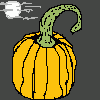
Art by  LordDirk
LordDirk
The Jingle Dress Dance is one of the principal women's pow wow dances originating from the Ojibwe peoples. The dress includes several rows of metal jingles that sound during the dance. I designed this dress myself. The yellows around the sleeves are kachina suns and the collar is a pattern I designed based on Puebloan patterns and colors. The fan of feathers is actually covering up the yoke which has three red flowers on it that are native to Arizona. I opted out of giving her moccasins to keep her more toony look together. I actually plan to make this dress one day and dance in it.
Watch this dance here: https://www.youtube.com/watch?v=dz_Y8bOUk7k
The story of this dance originates from an Ojibwe girl who had fallen gravely ill with no signs of recovery. The father of the girl sought a vision. In the vision he saw the dress and the instructions for the dance, and went about putting the dress together for his daughter, then asked her to do a few "springlike" steps, in which she always kept one foot on the ground. She started feeling better, and kept dancing. Finally, she recovered completely, and kept on dancing, and eventually she formed the first Jingle Dress Dance Society.
One aspect of the Jingle Dress Dance tradition that makes it so important in Indian Country is that the dance coincided with the suppression of Native American religion in the United States in 1921, with the outlawing of religious dancing. Despite that, it did not stop women from practicing the dance as a form of healing and ceremony and it has survived to this day, now danced all around Indian Country and at pow wows.
I am very pleased with how this drawing came out, and LordDirk as always has done a wonderful job capturing this culture. It comes at a time where I am often reminded just how many awful, stereotypical, and extremely racist portrayals of "Natives" are still being posted around FA, giving characters the most stereotyped features such as headdresses, poorly drawn/made buckskin clothing, and just these ridiculous aspects that have nothing to do with Native culture. They greatly dishonor any and all Native cultures of this continent. In this regard, I hope more of those stereotypes can be broken with art like this that portrays what we as Native people are really like, what we hold dear, and what our culture is like. We are not exclusive and we would love to show you more! I am always open to teaching people what I know and am always glad to answer your questions.
 LordDirk
LordDirkThe Jingle Dress Dance is one of the principal women's pow wow dances originating from the Ojibwe peoples. The dress includes several rows of metal jingles that sound during the dance. I designed this dress myself. The yellows around the sleeves are kachina suns and the collar is a pattern I designed based on Puebloan patterns and colors. The fan of feathers is actually covering up the yoke which has three red flowers on it that are native to Arizona. I opted out of giving her moccasins to keep her more toony look together. I actually plan to make this dress one day and dance in it.
Watch this dance here: https://www.youtube.com/watch?v=dz_Y8bOUk7k
The story of this dance originates from an Ojibwe girl who had fallen gravely ill with no signs of recovery. The father of the girl sought a vision. In the vision he saw the dress and the instructions for the dance, and went about putting the dress together for his daughter, then asked her to do a few "springlike" steps, in which she always kept one foot on the ground. She started feeling better, and kept dancing. Finally, she recovered completely, and kept on dancing, and eventually she formed the first Jingle Dress Dance Society.
One aspect of the Jingle Dress Dance tradition that makes it so important in Indian Country is that the dance coincided with the suppression of Native American religion in the United States in 1921, with the outlawing of religious dancing. Despite that, it did not stop women from practicing the dance as a form of healing and ceremony and it has survived to this day, now danced all around Indian Country and at pow wows.
I am very pleased with how this drawing came out, and LordDirk as always has done a wonderful job capturing this culture. It comes at a time where I am often reminded just how many awful, stereotypical, and extremely racist portrayals of "Natives" are still being posted around FA, giving characters the most stereotyped features such as headdresses, poorly drawn/made buckskin clothing, and just these ridiculous aspects that have nothing to do with Native culture. They greatly dishonor any and all Native cultures of this continent. In this regard, I hope more of those stereotypes can be broken with art like this that portrays what we as Native people are really like, what we hold dear, and what our culture is like. We are not exclusive and we would love to show you more! I am always open to teaching people what I know and am always glad to answer your questions.
Category Artwork (Digital) / All
Species Mouse
Size 907 x 1280px
File Size 128.3 kB
Listed in Folders
What is the status of Indian amongst native peoples? I can't speak from any perspective but as a caucasian, but I try never to use the phrase Indian when addressing a native. It seems too much like calling a person from New Jersey a Wisconsinite if you get really, really lost.
Do you have any idea what the dress would have been like before widespread access to metal for the jingly parts was more commonplace?
Do you have any idea what the dress would have been like before widespread access to metal for the jingly parts was more commonplace?
"Indian" "American Indian" and "Indian Country" are all common terms among Native people, and all are more common than "Native American" which is far less popular. Here is an article on some prominent Natives and their perspectives: http://indiancountrytodaymedianetwo.....voices-respond
Also, it's a misconception that we didn't use metal. It really depended on the region. The Ojibwe did not have a tradition of using metal but many people from where I am in the southwest, we did use metal long before colonization. I do not however think that any adaptation of new materials and colors should be anything to lament in our cultures. Contrary to popular belief, we were not a people who strived to live only in tradition, we were always advancing, progressive people and still are.
-Tonya 'Stands Firm'
Also, it's a misconception that we didn't use metal. It really depended on the region. The Ojibwe did not have a tradition of using metal but many people from where I am in the southwest, we did use metal long before colonization. I do not however think that any adaptation of new materials and colors should be anything to lament in our cultures. Contrary to popular belief, we were not a people who strived to live only in tradition, we were always advancing, progressive people and still are.
-Tonya 'Stands Firm'
Hrm. From what I'm getting, the answer seems to be "depends on what the person you're addressing is comfortable with."
But for my sake, I think I'll stick to 'native.' Seems no one voices irritation at being recognized as the native or the first, but if it has dismissive or colonial roots, it's more iffy.
But for my sake, I think I'll stick to 'native.' Seems no one voices irritation at being recognized as the native or the first, but if it has dismissive or colonial roots, it's more iffy.

 FA+
FA+

















Comments